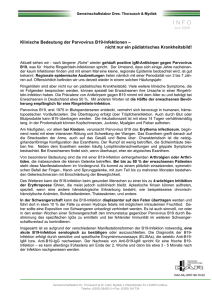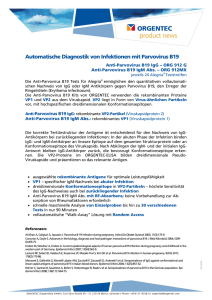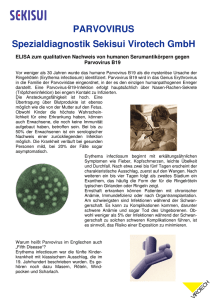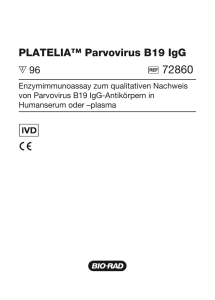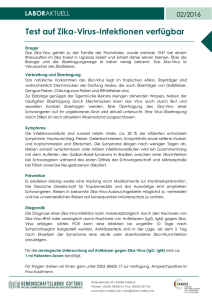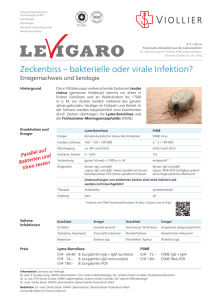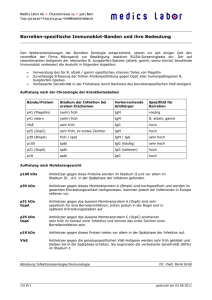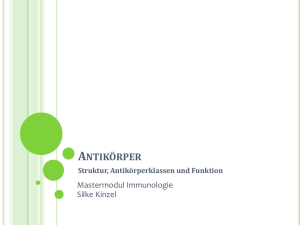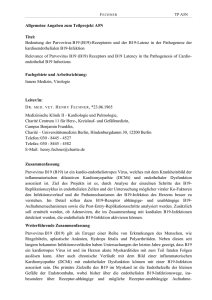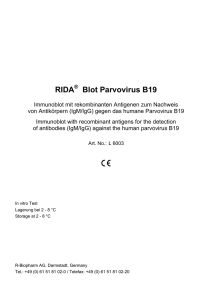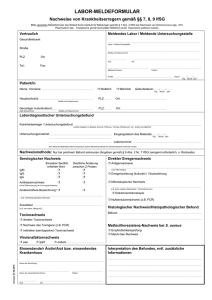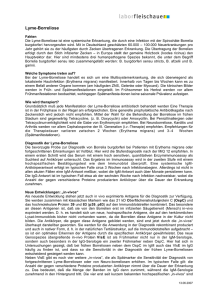recomWell Parvovirus B19 IgG recomWell Parvovirus B19 IgM
Werbung
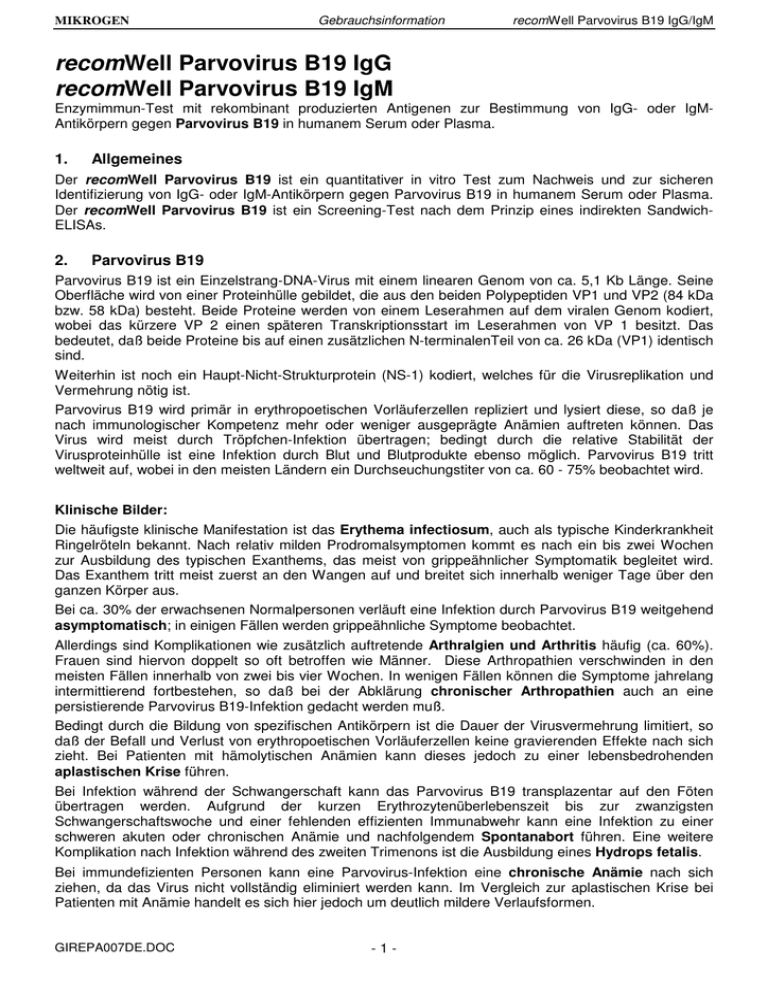
MIKROGEN Gebrauchsinformation recomWell Parvovirus B19 IgG/IgM recomWell Parvovirus B19 IgG recomWell Parvovirus B19 IgM Enzymimmun-Test mit rekombinant produzierten Antigenen zur Bestimmung von IgG- oder IgMAntikörpern gegen Parvovirus B19 in humanem Serum oder Plasma. 1. Allgemeines Der recomWell Parvovirus B19 ist ein quantitativer in vitro Test zum Nachweis und zur sicheren Identifizierung von IgG- oder IgM-Antikörpern gegen Parvovirus B19 in humanem Serum oder Plasma. Der recomWell Parvovirus B19 ist ein Screening-Test nach dem Prinzip eines indirekten SandwichELISAs. 2. Parvovirus B19 Parvovirus B19 ist ein Einzelstrang-DNA-Virus mit einem linearen Genom von ca. 5,1 Kb Länge. Seine Oberfläche wird von einer Proteinhülle gebildet, die aus den beiden Polypeptiden VP1 und VP2 (84 kDa bzw. 58 kDa) besteht. Beide Proteine werden von einem Leserahmen auf dem viralen Genom kodiert, wobei das kürzere VP 2 einen späteren Transkriptionsstart im Leserahmen von VP 1 besitzt. Das bedeutet, daß beide Proteine bis auf einen zusätzlichen N-terminalenTeil von ca. 26 kDa (VP1) identisch sind. Weiterhin ist noch ein Haupt-Nicht-Strukturprotein (NS-1) kodiert, welches für die Virusreplikation und Vermehrung nötig ist. Parvovirus B19 wird primär in erythropoetischen Vorläuferzellen repliziert und lysiert diese, so daß je nach immunologischer Kompetenz mehr oder weniger ausgeprägte Anämien auftreten können. Das Virus wird meist durch Tröpfchen-Infektion übertragen; bedingt durch die relative Stabilität der Virusproteinhülle ist eine Infektion durch Blut und Blutprodukte ebenso möglich. Parvovirus B19 tritt weltweit auf, wobei in den meisten Ländern ein Durchseuchungstiter von ca. 60 - 75% beobachtet wird. Klinische Bilder: Die häufigste klinische Manifestation ist das Erythema infectiosum, auch als typische Kinderkrankheit Ringelröteln bekannt. Nach relativ milden Prodromalsymptomen kommt es nach ein bis zwei Wochen zur Ausbildung des typischen Exanthems, das meist von grippeähnlicher Symptomatik begleitet wird. Das Exanthem tritt meist zuerst an den Wangen auf und breitet sich innerhalb weniger Tage über den ganzen Körper aus. Bei ca. 30% der erwachsenen Normalpersonen verläuft eine Infektion durch Parvovirus B19 weitgehend asymptomatisch; in einigen Fällen werden grippeähnliche Symptome beobachtet. Allerdings sind Komplikationen wie zusätzlich auftretende Arthralgien und Arthritis häufig (ca. 60%). Frauen sind hiervon doppelt so oft betroffen wie Männer. Diese Arthropathien verschwinden in den meisten Fällen innerhalb von zwei bis vier Wochen. In wenigen Fällen können die Symptome jahrelang intermittierend fortbestehen, so daß bei der Abklärung chronischer Arthropathien auch an eine persistierende Parvovirus B19-Infektion gedacht werden muß. Bedingt durch die Bildung von spezifischen Antikörpern ist die Dauer der Virusvermehrung limitiert, so daß der Befall und Verlust von erythropoetischen Vorläuferzellen keine gravierenden Effekte nach sich zieht. Bei Patienten mit hämolytischen Anämien kann dieses jedoch zu einer lebensbedrohenden aplastischen Krise führen. Bei Infektion während der Schwangerschaft kann das Parvovirus B19 transplazentar auf den Föten übertragen werden. Aufgrund der kurzen Erythrozytenüberlebenszeit bis zur zwanzigsten Schwangerschaftswoche und einer fehlenden effizienten Immunabwehr kann eine Infektion zu einer schweren akuten oder chronischen Anämie und nachfolgendem Spontanabort führen. Eine weitere Komplikation nach Infektion während des zweiten Trimenons ist die Ausbildung eines Hydrops fetalis. Bei immundefizienten Personen kann eine Parvovirus-Infektion eine chronische Anämie nach sich ziehen, da das Virus nicht vollständig eliminiert werden kann. Im Vergleich zur aplastischen Krise bei Patienten mit Anämie handelt es sich hier jedoch um deutlich mildere Verlaufsformen. GIREPA007DE.DOC -1- recomWell Parvovirus B19 IgG/IgM Gebrauchsinformation MIKROGEN Zusätzliche Organmanifestationen wie etwa hepatitische Dysfunktionen, respiratorische Erkrankungen, Parvovirus B19-assozierte Myokarditis u.a. sind in jüngster Zeit beschrieben worden. In Einzelfällen werden auch chronische Anämien und Arthropathien verursacht durch persistierende Parvovirus B19-Infektionen in Patienten ohne bekannten Immundefekt gefunden. 3. Diagnostik Eine Erstinfektion durch Parvovirus B19 wird durch das Vorhandensein spezifischer IgM Antikörper dokumentiert. IgM-Titer werden meist etwa 10 Tage nach Infektion und damit meist gleichzeitig mit dem Auftreten der Symptomatik gefunden. IgG-Titer sind wenige Tage später zu finden und persistieren in der Regel lebenslang. Für den Antikörpernachweis können die Strukturproteine des Virus verwendet werden. Bei Patienten mit Verdacht auf eine frische oder persistierende Infektion (chronische Anämie, chronische Arthropathien, Immundefizienz, Ausschlußdiagnostik) sollte immer auch ein Virusnachweis mittels PCR durchgeführt werden. 4. Testprinzip - recomWell Parvovirus B19 Für den recomWell Parvovirus B19 IgG und IgM werden ein rekombinant produzierter spezifischer Teil des VP1, sowie rekombinante, eukaryotische VP2-Partikel verwendet. Durch den Einsatz der VP2Partikel wird eine zusätzliche Präsentation von Konformations-Epitopen zu den ansonsten dargebotenen linearen Epitopen erreicht. Insgesamt gesehen ist es damit möglich, einen Enzymimmun-Test ohne störende und kreuzreagierende Proteine anzubieten. 5. Packungsinhalt Die Reagenzien einer Packung reichen für 96 Bestimmungen. Jeder Reagenziensatz enthält: 100 ml Waschpuffer (zehnfach konzentriert) Enthält Phosphat-Puffer, NaCl, Detergenz, Konservierungsmittel: MIT (0,01%) und Oxypyrion (0,1%) 125 ml Verdünnungspuffer (gebrauchsfertig) Enthält Protein, Detergenz und blauen Farbstoff. Konservierungsmittel: MIT (0,01%) und Oxypyrion (0,1%) 12 ml Chromogenes Substrat Tetramethylbenzidin (TMB, gebrauchsfertig) 12 ml Stopplösung 24,9% Phosphorsäure (H3PO4) 1 Gebrauchsinformation 1 Auswertebogen 2 Stück Abdeckfolien -2- GIREPA007DE.DOC Gebrauchsinformation MIKROGEN 5.1. recomWell Parvovirus B19 IgG/IgM recomWell Parvovirus B19 IgG Jeder Reagenziensatz enthält zusätzlich zu den unter Punkt 5 aufgeführten Komponenten: 12 x 8 Kavit. 150 µl Mikrotiterplatte (Riegel rot markiert) beschichtet mit rekombinanten Parvovirus B19 Antigenen im Vakuum-Druckverschlußbeutel Positive Kontrolle (Violette Verschlußkappe) enthält MIT (0,1%) und Oxypyrion (0,1%) 150 µl Cutoff Kontrolle (Gelbe Verschlußkappe) enthält MIT (0,1%) und Oxypyrion (0,1%) 150 µl Negative Kontrolle (Weiße Verschlußkappe) enthält MIT (0,1%) und Oxypyrion (0,1%) 250 µl Anti-human IgG Konjugat (101fach konzentriert, Rote Verschlußkappe) enthält NaN3 (<0,1%), MIT (<0,01%) und Chlorazetamid (<0,1%) 5.2. recomWell Parvovirus B19 IgM Jeder Reagenziensatz enthält zusätzlich zu den unter Punkt 5 aufgeführten Komponenten: 12 x 8 Kavit. 150 µl Mikrotiterplatte (Riegel grün markiert) beschichtet mit rekombinanten Parvovirus B19 Antigenen im Vakuum-Druckverschlußbeutel Positive Kontrolle (Schwarze Verschlußkappe) enthält MIT (0,1%) und Oxypyrion (0,1%) 150 µl Cutoff Kontrolle (Farblose Verschlußkappe) enthält MIT (0,1%) und Oxypyrion (0,1%) 150 µl Negative Kontrolle (Weiße Verschlußkappe) enthält MIT (0,1%) und Oxypyrion (0,1%) 250 µl Anti-human IgM Konjugat (101fach konzentriert, Grüne Verschlußkappe) enthält NaN3 (<0,1%), MIT (<0,01%) und Chlorazetamid (<0,1%) 6. Zusätzlich benötigte Reagenzien - erforderliches Zubehör Deionisiertes Wasser (hohe Qualität), Teströhrchen, Mikropipetten, Inkubationsschrank 37°C, Mikrotiterplatten-Photometer 7. Hinweise zum Test und den Reagenzien 7.1. Vorsichtsmaßregeln Für die Herstellung der Kontrollseren wird Blut von Spendern verwendet, bei denen keine Antikörper gegen HIV 1/2, HCV und kein Hepatitis-Bs-Antigen nachgewiesen wurden. Da trotzdem eine Infektion nicht mit Sicherheit ausgeschlossen werden kann, muss das Produkt mit der gleichen Sorgfalt behandelt werden wie eine Patientenprobe. Während des gesamten Testablaufs müssen geeignete Einmalhandschuhe getragen werden. Phosphorsäure ist reizend. Kontakt mit Haut und Schleimhäuten unbedingt vermeiden. Die Konjugate enthalten Natriumazid, MIT (Methylisothiazolon) und Chlorazetamid. Die Kontrollen, der Verdünnungspuffer und der Waschpuffer enthalten MIT und Oxypyrion. Eine Berührung mit der Haut oder Schleimhaut ist zu vermeiden. Sämtliche Reagenzien und Materialien, die mit potentiell infektiösen Proben in Berührung kommen, müssen mit geeigneten Desinfektionsmitteln behandelt oder mindestens 1 Stunde bei 121°C autoklaviert werden. GIREPA007DE.DOC -3- recomWell Parvovirus B19 IgG/IgM 7.2. Gebrauchsinformation MIKROGEN Hinweise zur Handhabung Die Packungen tragen ein Verfallsdatum, nach dessen Erreichen keine Qualitätsgarantie mehr übernommen werden kann. Die Komponenten Verdünnungspuffer, Waschpuffer, Substrat und Stopplösung für die recomWell-Teste können parameter- und chargenübergreifend eingesetzt werden. Dabei ist die Haltbarkeit dieser Komponenten zu beachten. Die Kontrollseren und Konjugate sind chargengebunden und dürfen nicht parameter- oder chargenübergreifend eingesetzt werden. Der Test ist nur von geschultem und autorisiertem Fachpersonal durchzuführen. Die Abdeckfolien sind für den einmaligen Gebrauch bestimmt. Bei substantiellen Änderungen am Produkt, bzw. der Anwendungsvorschrift kann die Anwendung außerhalb der von MIKROGEN vorgegebenen Zweckbestimmung liegen. Automatisierung ist möglich, nähere Informationen erhalten Sie von MIKROGEN. 7.3. Herstellung der Lösungen Die Nachweisreagenzien reichen für 96 IgG- oder IgM-Bestimmungen. Die unten genannten Mengenangaben beziehen sich jeweils auf die Bearbeitung von einem Mikrotiterplattenstreifen mit 8 Kavitäten. Bei der Verwendung von mehreren Mikrotiterplattenstreifen gleichzeitig müssen die angegebenen Mengen jeweils mit der Anzahl der verwendeten Mikrotiterplattenstreifen multipliziert werden. Substrat und Stopplösung sind gebrauchsfertig. 7.3.1. Herstellung des gebrauchsfertigen Waschpuffers Das Waschpuffer-Konzentrat wird 1 + 9 mit H2O deion. verdünnt. Pro einem Mikrotiterplattenstreifen mit 8 Kavitäten werden 5 ml Konzentrat mit 45 ml H2O deion. gemischt. 7.3.2. Herstellung der Konjugatlösung Pro einem Mikrotiterplattenstreifen mit 8 Kavitäten werden 1 ml Verdünnungspuffer mit je 10 µl antihuman IgG Peroxidase-Konjugat (Rote Verschlusskappe) oder IgM Peroxidase-Konjugat (Grüne Verschlusskappe) in einem sauberen Gefäß versetzt und gut gemischt (Verdünnung 1 + 100). 7.4. Lagerung und Haltbarkeit Die Reagenzien vor und nach Gebrauch bei 2°C - 8°C lagern. Der gebrauchsfertige Waschpuffer kann auch in größerer Menge hergestellt werden. Der gebrauchsfertige Waschpuffer kann für die Verwendung bei weiteren Testen vier Wochen bei 2°C - 8°C oder eine Woche bei Raumtemperatur gelagert werden. Die Verdünnung der Proben, der Kontrollen sowie die Konjugatlösung müssen immer frisch zubereitet werden. 8. Probenmaterial Das Probenmaterial kann Serum oder Plasma sein, das nach Entnahme möglichst rasch vom Blutkuchen getrennt wurde. Eine mikrobielle Kontamination der Probe ist unbedingt zu vermeiden. Unlösliche Stoffe sind vor der Inkubation durch Zentrifugation aus der Probe zu entfernen. Achtung! Sollen die Bestimmungen nicht sofort erfolgen, kann das Probenmaterial bis zu 2 Wochen bei 2°C - 8°C aufbewahrt werden. Eine längere Lagerung der Proben ist durch Aufbewahrung bei -20°C oder tiefer möglich. Ein wiederholtes Einfrieren und Auftauen der Proben wird wegen der Gefahr fehlerhafter Resultate nicht empfohlen. -4- GIREPA007DE.DOC MIKROGEN Gebrauchsinformation recomWell Parvovirus B19 IgG/IgM 9. Testdurchführung 9.1. Testvorbereitung Vor Gebrauch sollen alle Reagenzien etwa 30 Minuten auf Raumtemperatur (18°C - 25°C) gebracht werden. Zur Vermeidung von Kondenswasserbildung in der Mikrotiterplatte muss diese im verschlossenen Beutel auf Raumtemperatur gebracht werden. Nach der Entnahme der benötigten Riegel soll die Platte im Beutel wieder verschlossen werden und in den Kühlschrank gegeben werden. Vor Gebrauch die Kontrollseren und Patientenseren, sowie die konzentrierten Konjugate gut durchmischen und soweit möglich anschließend kurz abzentrifugieren, um die Flüssigkeit am Boden der Gefäße zu sammeln. 9.2. Vorbereitung der Proben und Kontrollen In 1 ml Verdünnungspuffer werden jeweils 10 µl Probe bzw. Kontrolle pipettiert und gut gemischt (Verdünnung 1 + 100). Bei jedem Testansatz müssen eine negative Kontrolle, eine Cutoff Kontrolle und eine Positive Kontrolle mitgeführt werden, die ebenso wie die Patientenproben verdünnt werden. Der spezifische Nachweis von IgM-Antikörpern kann in Anwesenheit von Rheumafaktoren zu falsch-positiven Testergebnissen führen. Deshalb empfehlen wir, die Seren für die IgMBestimmung mit Rheumafaktor-Absorbens vorzubehandeln. Auch für diesem Fall ist die Probenverdünnung 1 + 100 im Ansatz unbedingt einzuhalten. Die IgM-Kontrollseren sind nicht mit dem RF-Absorbens vorzubehandeln ! 9.3. Inkubation der Proben Die Mikrotiterplatte wird dem Druckverschlußbeutel entnommen. Von den verdünnten Proben und verdünnten Kontrollen werden 100 µl pro Kavität pipettiert. Dabei wird von der Negativen Kontrolle, der Positiven Kontrolle und den Patientenproben mindestens ein Wert angelegt, während die Cutoff Kontrolle doppelt angelegt werden muss. Vorzugsweise wird je eine Cutoff Kontrolle am Anfang der Serie und am Ende der Serie pipettiert. Die Mikrotiterplatte wird bei manueller Abarbeitung sorgfältig mit ungebrauchter Abdeckfolie abgeklebt und 1 Stunde bei 37°C inkubiert. 9.4. Waschen Die Kavitäten werden vollständig geleert und anschließend viermal mit je 300 µl gebrauchsfertigem Waschpuffer pro Kavität gewaschen. Es wird empfohlen, diesen Schritt mit einem entsprechenden ELISA-Waschgerät durchzuführen. Es ist unbedingt darauf zu achten, dass der Waschpuffer zwischen den Waschschritten vollständig entfernt wird. Nach Beenden des letzten Waschschrittes (auch bei Verwendung eines Waschgerätes) die Platte auf einem Papiertuch ausschlagen, um letzte Flüssigkeitsreste in den Kavitäten zu entfernen. 9.5. Inkubation mit Peroxidase-Konjugat Von der verdünnten Konjugatlösung (s.7.3.2) werden 100 µl pro Kavität pipettiert. Die Mikrotiterplatte wird bei manueller Abarbeitung sorgfältig mit ungebrauchter Abdeckfolie abgeklebt und 30 Minuten bei 37°C inkubiert. 9.6. Waschen Die Kavitäten werden geleert und wie unter 0 gewaschen. 9.7. Substratreaktion Die Substratlösung ist gebrauchsfertig. Es werden 100 µl pro Kavität pipettiert. Abkleben der Platte ist nicht erforderlich. Die Mikrotiterplatte wird 30 Minuten bei Raumtemperatur unter Schutz vor direkter Sonneneinstrahlung inkubiert. Die Zeit wird ab Pipettieren der ersten Kavität gerechnet. GIREPA007DE.DOC -5- recomWell Parvovirus B19 IgG/IgM 9.8. Gebrauchsinformation MIKROGEN Abstoppen der Reaktion Zum Abstoppen der Reaktion werden 100 µl Stopplösung pro Kavität pipettiert. Dabei ist dasselbe Pipettierschema wie beim Pipettieren der Substratlösung einzuhalten. 9.9. Messung der Extinktionen Die Extinktionen der einzelnen Kavitäten werden in einem Mikrotiterplatten-Photometer bei 450 nm und der Referenzwellenlänge 650 nm (620 bis 650 nm zulässig) gemessen. Der Nullabgleich erfolgt gegen Luft. Die Messung muss innerhalb von 60 Minuten nach Abstoppen der Reaktion erfolgen. 10. Kurzanleitung der Testdurchführung Verdünnungen: • Verdünnung von Proben und 1 + 100 mit Verdünnungspuffer Kontrollen 10 µl + 1 ml je Probe bzw. Kontrolle • Konjugatverdünnung: 1 + 100 mit Verdünnungspuffer 10 µl + 1 ml je Mikrotiterplattenstreifen • Waschpufferverdünnung: 1 + 9 mit H2O deion. 5 ml + 45 ml je Mikrotiterplattenstreifen Testschritte: • Probeninkubation: 100 µl pro Kavität 60 min bei 37°C • Waschschritt: 300 µl pro Kavität viermal • Konjugatinkubation: 100 µl pro Kavität 30 min bei 37°C • Waschschritt: 300 µl pro Kavität viermal • Substratinkubation: 100 µl pro Kavität 30 min bei Raumtemperatur • Abstoppen: 100 µl pro Kavität • Photometrieren: 450 / 650 (620) nm 11. Validierung und Auswertung 11.1. Validierung Cutoff Kontrolle: Von den Extinktionswerten der beiden Cutoffs (am Anfang und am Ende der Serie) wird der Mittelwert gebildet. Der Test ist unter folgenden Bedingungen auswertbar: Die einzelnen Extinktionswerte der Doppelbestimmung der Cutoff Kontrolle weichen nicht mehr als 20% von ihrem Mittelwert ab. • Extinktion negative Kontrolle ≤ 0,150 • Extinktion Cutoff Kontrolle (E Cutoff – E neg. Kontr. ≥ 0,050) - Extinktion negative Kontrolle ≥ 0,050 • Extinktion positive Kontrolle (E pos. Kontr. – E Cutoff ≥ 0,300) - Extinktion Cutoff Kontrolle ≥ 0,300 -6- GIREPA007DE.DOC Gebrauchsinformation MIKROGEN 11.2. recomWell Parvovirus B19 IgG/IgM Auswertung 11.2.1. Qualitative Auswertung Cutoff (Grenzwert): Extinktionsmittelwert der Cutoff Kontrolle Graubereich: untere Grenze = Cutoff obere Grenze = Cutoff + 20% (Cutoff x 1,2) • Proben mit Extinktionswerten oberhalb des Graubereiches sind als positiv zu betrachten. • Proben mit Extinktionswerten unterhalb des Graubereiches sind als negativ zu betrachten. • Proben mit Extinktionswerten im Graubereich sind grenzwertig. Sie sollten erneut getestet werden. Sind sie nach dem zweiten Test wiederum grenzwertig, empfiehlt es sich, nach einiger Zeit eine weitere Probe zu nehmen und zu testen (vgl. 11.3). 11.2.2. Quantitative Auswertung Den Extinktionswerten wird mit Hilfe einer Formel die entsprechende Antikörperaktivität in Units pro ml zugeordnet. U/ml Probe = (Extinktion Probe / Extinktion Cutoff) x 20 Graubereich: untere Grenze = 20 U/ml obere Grenze = 24 U/ml • U/ml Probe > 24 positives Testergebnis • U/ml Probe < 20 negatives Testergebnis • 20 ≤ U/ml Probe ≤ 24 grenzwertiges Testergebnis 11.3. Hinweise zur Interpretation der Testergebnisse Ein negatives recomWell Parvovirus B19 Testresultat kann eine Infektion mit dem humanen Parvovirus B19 nicht ausschließen. Bei klinischem Verdacht auf eine Infektion mit Parvovirus B19 und negativem serologischem Befund sollte nach zwei Wochen eine weitere Probenentnahme und Testung erfolgen. Empfehlenswert ist in diesem Fall auch die Durchführung eines Virusnachweises mittels PCR. Serologische Testergebnisse sollten immer in Zusammenhang mit dem klinischen Bild gesehen werden. Blutspendeseren einer Blutbank (n= 100) in Deutschland waren im IgM bis zu 1 % reaktiv; die Gesamtbewertung im Western Blot ist hier negativ. Mögliche Störseren (Schwangere, Rheumafaktorpositive, frische EBV-Infektionen oder ANA-positive s. 12.4), die im IgM positiv waren, zeigten auch im Western Blot ein positives Resultat oder zumindest reaktive Banden. Wir empfehlen generell, positive und grenzwertige ELISA-Resultate in einem Bestätigungstest (Western Blot) nachzuprüfen. 12. Klinische Ergebnisse 12.1. Positive Seren Die Seren wurden aufgrund ihrer Reaktivität im ELISA A ausgewählt. IgG ELISA A IgM° n = 115 recomWell n = 47 positiv grenzwertig 112 2 grenzwertig 1 negativ 0 positiv ELISA A recomWell positiv grenzwertig positiv 46 1 0 grenzwertig 0 0 0 negativ 0 0 ° mit RF-Absorption (verwendet: RF-Absorbens, Fa. Dade-Behring) GIREPA007DE.DOC -7- recomWell Parvovirus B19 IgG/IgM Gebrauchsinformation MIKROGEN 12.2. Vergleich mit anderen Enzymimmun-Testen bezüglich des WHO-Standards für humanes Anti-Parvovirus B19 Serum, IgG Der WHO-Standard (NIBSC code 93/724) wurde vom National Institute for Biological Standards and Control (Hertfordshire, UK) bezogen. grenzwertig positiv Extinktion bei 50 IU Extinktion bei 100 IU recomWell ≈ 2 IU ≈ 3 IU 2,5 2,8 ELISA A ≈ 2 IU ≈ 3 IU 1,5 1,7 ELISA B ≈ 3,5 IU ≈ 4,5 IU 1,4 1,7 12.3. Blutspender recomWell IgG positiv Blutbank-Seren n = 100) recomWell IgM° positiv 81/100 1/100 Blutbank-Plasmen (inaktiviert) n = 100 81/100 1/100 Blutbank-Plasmen n = 100 82/100 2/100 IgM U/ml* 99 recomBlot IgM # negativ (keine Banden, Background) Bewertungskriterien recomWell Parvovirus B19: • U/ml Probe > 24 positives Testergebnis • U/ml Probe < 20 negatives Testergebnis • 20 ≤ U/ml Probe ≤ 24 grenzwertiges Testergebnis ° mit RF-Absorption (verwendet: RF-Absorbens, Fa. Dade-Behring) # Bewertungskriterien recomBlot Parvovirus B19: IgG positiv IgG fraglich IgG negativ mindestens VPN + oder 2+ , andere Banden können, müssen aber nicht erscheinen VPC isoliert mindestens +, oder VPN und VPC (evtl. noch VP1S) +/keine Reaktion oder andere Konstellationen; insbesondere schwache, isolierte Bande VP1S IgM positiv IgM fraglich IgM negativ VPN + / 2+ und VP-C mindestens +, VP1S kann, muß aber nicht erscheinen VPN oder VPC isoliert + oder VPN und VPC +/keine Reaktion oder andere Konstellationen wie oben -8- GIREPA007DE.DOC Gebrauchsinformation MIKROGEN 12.4. recomWell Parvovirus B19 IgG/IgM Mögliche Störseren recomWell recomWell IgM recomBlot IgG IgM° U/ml* IgM# positiv positiv 65/117 1/117 (56%) (1 %) 48/55 (87%) Schwangere Rheumafaktorpositive Frische EBVInfektionen ANA-positive 149 Positiv (VPN 2+, VPC 3+, VP1S +/-) 3/55 23 Positiv (VPN +, VPC +) (5%) 27 Fraglich (NS1 2+, VPN 3+, VP1S 3+) 46 Positiv (VPN 2+, VPC 3+, VP1S +/-) 24/47 3/47 28 Fraglich (VPN +/-,VPC +) (51%) (6%) 33 Positiv (NS1 2+, VPN 3+, VPC 3+, VP1S 2+) 30 Positiv (VPN +,VPC +,VP1S +/-) 26 Fraglich (VPC 2+) 25/38 1/38 (66%) (3%) *,# Bewertungskriterien siehe Punkt 12.3 ° mit RF-Absorption (verwendet: RF-Absorbens, Fa. Dade-Behring) 13. Literatur Die ausführliche Literaturliste finden Sie im englischen Teil der Gebrauchsinformation ab Seite 16. Auf Anforderung senden wir Ihnen gerne weiterführende Literatur zur Parvovirus B19 Diagnostik zu. 14. Erklärung der Symbole Die Tabelle mit der Erklärung der Symbole finden Sie im englischen Teil der Gebrauchsinformation auf Seite 18. GIREPA007DE.DOC -9- recomWell Parvovirus B19 IgG/IgM Instructions for use MIKROGEN recomWell Parvovirus B19 IgG recomWell Parvovirus B19 IgM Enzyme immunoassay with recombinant antigens for the detection of IgG or IgM antibodies against Parvovirus B19 in human serum or plasma. 1. General Aspects recomWell Parvovirus B19 is a quantitative in vitro test for the detection and safe identification of IgG or IgM antibodies against Parvovirus B19 in human serum or plasma. recomWell Parvovirus B19 is a screening test based on the principle of an indirect sandwich ELISA. 2. Parvovirus B19 Parvovirus B19 is a single-stranded DNA virus with a linear genome, ca. 5.1 Kb in length. Its surface is formed by a protein shell which consists of two polypeptides, 84 kDa and 58 kDa in size (VP-1 and VP2). Both proteins are coded from one reading frame on the viral genome; the shorter VP-2 has a transcription start at a point further along on the reading frame of VP-1. This means that both proteins are identical with the exception of a ca. 26 kDa N-terminal segment of VP 1. Also coded is a major non-structural protein (NS-1), which is required for virus replication and propagation. Parvovirus B19 replicates primarily in erythropoietic precursor cells, causing cell lysis. Therefore, depending on the immunologic competence, more or less pronounced anemias can occur. This virus is usually transmitted by droplet infection. As a result of the relative stability of the virus protein shell, infection via blood and blood products is also possible. Parvovirus B19 is found world-wide, about 60 75 % of the population in most countries are infected. Clinical Picture: The most frequent clinical manifestation produced is erythema infectiosum, also known as fifth disease, a typical childhood disease. Following relatively mild prodromal symptoms, a typical exanthem appears after one to two weeks, which is usually accompanied by symptoms similar to those of flu. The exanthem generally begins on the cheeks and spreads over the entire body within a few days. In the case of ca. 30 % of normal adults, a Parvovirus B19 infection progresses largely asymptomatically. In some cases, symptoms similar to those of flu are observed. However, complications such as arthralgia and arthritis occur frequently (ca. 60 %). Women are affected by these complications twice as often as men. In most cases, these arthropathies disappear within two to four weeks. But in a few cases, the symptoms can continue intermittently for many years. Consequently, in the clarification of chronic arthropathies, a persistent Parvovirus B19 infection must also be considered. The duration of virus multiplication is limited because of the formation of specific antibodies. Therefore, the infection and loss of erythropoietic precursor cells cause no serious effects. However, this can result in a life threatening aplastic crisis in patients suffering from haemolytic anemias. If infection occurs during pregnancy, Parvovirus B19 can be transplacentally transmitted to the fetus. Since the survival time of erythrocytes is short up to the twentieth week of pregnancy and an efficient immune response is lacking, infection can cause severe acute or chronic anemia and lead to a spontaneous abortion. Another complication after infection during the second trimester is the formation of hydrops fetalis. In immunodeficient persons, a Parvovirus infection can result in chronic anemia because the virus cannot be completely eliminated. However, this type of anemia has a much milder course when compared to the aplastic crisis of anemic patients. Additional organ manifestations such as hepatic dysfunction, respiratory diseases, Parvo B19 associated myocarditis etc have been described recently. In individual cases, chronic anemias and arthropathies are also caused by persistent Parvovirus B19 infections in patients without a known immune defect. - 10 - GIREPA007DE.DOC Instructions for use MIKROGEN 3. recomWell Parvovirus B19 IgG/IgM Diagnosis A primary infection with Parvovirus B19 is documented by the presence of specific IgM antibodies. IgM titers are generally found about 10 days after infection, at the same time as the symptoms appear. IgG titers are found a few days later and, as a rule, persist lifelong. The structural proteins of the virus can be used for antibody detection. In patients suspected of having a fresh or persistent infection (chronic anemia, chronic arthropathies, immunodeficiency, diagnosis of exclusion), virus detection by means of PCR should always be carried out as well. 4. Test Principle - recomWell Parvovirus B19 For recomWell Parvovirus B19 IgG and IgM recombinant, eukaryotic VP2 particles and a recombinant specific part of VP1 are used. The VP2 particles enable an additionally presentation of conformation epitopes to the usually presented linear epitopes. In this way, an optimal presentation without other interfering and cross reacting proteins can be achieved. 5. Package contents The reagents in one pack are sufficient for 96 determinations. Each reagent set contains: 100 ml Wash buffer (ten times the concentration) Contains phosphate buffer, NaCl, detergent and preservatives MIT (0,01%) and Oxypyrion (0,1%) 125 ml Dilution buffer (ready-for-use) Contains protein, detergent and blue dye, preservatives MIT (0,01%) and Oxypyrion (0,1%) 5.1. 12 ml Chromogenic substrate tetramethylbenzidine (TMB, ready-for-use) 12 ml Stop solution 24,9 % Phosphoric acid (H3PO4) 1 Instructions for use 1 Evaluation form 2 pieces Sealing tape recomWell Parvovirus B19 IgG Additionally to the components listed under Point 5 each reagent set contains: 12 x 8 wells 150 µl Microplate (section marked in red) coated with recombinant Parvovirus B19 antigens in vacuum-pressure sealed bag Positive control (violet screw cap) Preservatives: MIT (0,1%) and Oxypyrion (0,1) 150 µl Cutoff control (yellow screw cap) Preservatives: MIT (0,1%) and Oxypyrion (0,1) 150 µl Negative control (white screw cap) Preservatives: MIT (0,1%) and Oxypyrion (0,1) 250 µl Anti-human IgG conjugate (101 times the concentration, red screw cap) contains NaN3 (<0,1%), MIT (<0,01%), Chloracetamide (<0,1%) GIREPA007DE.DOC - 11 - recomWell Parvovirus B19 IgG/IgM 5.2. Instructions for use MIKROGEN recomWell Parvovirus B19 IgM Additionally to the components listed under Point 5 each reagent set contains: 12 x 8 wells. 150 µl Microplate (section marked in green) coated with recombinant Parvovirus B19 antigens in vacuum-pressure sealed bag Positive control (black screw cap) Preservatives: MIT (0,1%) and Oxypyrion (0,1) 150 µl Cutoff control (colourless screw cap) Preservatives: MIT (0,1%) and Oxypyrion (0,1) 150 µl Negative control (white screw cap) Preservatives: MIT (0,1%) and Oxypyrion (0,1) 250 µl Anti-human IgM conjugate (101 times the concentration, green screw cap) contains NaN3 (<0,1%), MIT (<0,01%), Chloracetamide (<0,1%) 6. Additional reagents and accessory equipment required Deionised water (high quality), test tubes, micro pipettes, incubator 37°C, microplate photometer. 7. Information on test and reagents 7.1. Precautions Control sera are from blood donors verified for the absence of antibodies to HIV 1/2, HCV and no Hepatitis Bs-antigen. Since an infection cannot be excluded with absolute certainty despite this precaution, the product must be treated with the same care as the patient sample. Suitable single-use gloves must be worn during the entire test procedure. Phosphoric acid is an irritant. Avoid all contact with skin or mucosa. 7.2. The conjugates contain sodium azide, MIT (methylisothiazolone) and Chloracetamide. The controls, dilution buffer and wash buffer contain MIT and Oxypyrion. Avoid contact with skin or mucosa. All reagents and materials contaminated with potentially infectious samples must be treated with suitable disinfectants or autoclaved at 121°C for at least 1 hour. Handling information A quality guarantee can only be given up to the expiry date on the packages. The components dilution buffer, wash buffer, substrate and stop solution for all recomWell-tests can be used irrespective of parameter or lot. Please mind the expire date of the components. All control sera and conjugates are to be used with the lot noted on the cover of the kit, they must not be used with other parameters or lots. The test must be performed by well-trained and authorised qualified personnel. The sealing tapes are to be used only once. In case of substantial modifications of the product or the instructions for use, the application of the test might differ from the purpose intended by MIKROGEN. Automation is possible, please refer to MIKROGEN for details. 7.3. Preparation of the solutions The test reagents are sufficient for 96 IgG or IgM tests. The amounts indicated below refer to processing of a microplate strip with 8 wells. If several microplate strips are used at the same time, the amounts indicated must be multiplied by the number of microplate strips used. Substrate and stop solution are ready to use. 7.3.1. Preparation of ready-to-use wash buffer The wash buffer concentrate is diluted 1 + 9 with deionised H2O. 5 ml concentrate are mixed with 45 ml deionised H2O per microplate strip with 8 wells. - 12 - GIREPA007DE.DOC MIKROGEN Instructions for use recomWell Parvovirus B19 IgG/IgM 7.3.2. Preparation of conjugate solution Per each microplate strip with 8 wells, 10 µl anti-human IgG peroxidase conjugate (red cap) or IgM peroxidase conjugate (green cap) are added to 1 ml dilution buffer in a clean vessel and mixed well (dilution 1 + 100). 7.4. Storage and stability Store the reagents at 2°C - 8°C before and after use. The ready-to-use wash buffer can be prepared in larger amounts. Ready-to-use wash buffer may be stored at 2°C - 8°C for four weeks or at room temperature for one week for use in further tests. The sample dilutions, controls and conjugate solution must always be prepared freshly. 8. Sample material The sample material can be serum or plasma that is separated from the coagulum as soon as possible after sampling. A microbial contamination of the sample has to be avoided at all costs. Insoluble substances must be removed from the sample prior to incubation by centrifugation. Important! If the tests are not carried out immediately, the samples can be stored for up to 2 weeks at 2°C 8°C. Longer storage of the samples is possible at -20°C or below. Repeated freezing and thawing of the samples is not recommended because this may affect the quality of the results. 9. Test procedure 9.1. Test preparations Temper all reagents to room temperature (18°C - 25°C) before use for about 30 minutes. To avoid condensation of water in the microplate, it must be brought up to room temperature in the closed bag. After the required section is removed, the bag containing the plate must be reclosed and placed in the refrigerator. Before use, the control and patient sera and concentrated conjugates must be mixed well and briefly centrifuged if practicable to collect the liquid at the bottom of the tubes. 9.2. Preparation of samples and controls Pipette 10 µl of sample or control into 1 ml dilution buffer each and mix well (dilution 1 + 100). A negative control, cutoff control and positive control must be run parallel to each test run and diluted just like the patient samples. The specific detection of IgM antibodies may lead to false positive results in the presence of rheumatoid factors. Therefore we recommend a pre-treatment of the sera with RF absorbent for the detection of IgM antibodies. Also in this case, a sample dilution of 1+100 is required. Avoid the pre-treatment of the IgM control sera. 9.3. Incubation of the samples The microplate is removed from the pressure-sealed bag. Pipette 100 µl per well of the diluted samples and diluted controls. One value is tested for each negative control, positive control and patient sample, whereas the cutoff control must be double-tested. It is preferable to pipette one cutoff control at the beginning and again at the end of the series. In manual processing, the microplate is carefully taped over with unused sealing tape and incubated for 1 hour at 37°C. 9.4. Washing procedure The wells are emptied completely, then washed four times, each time with 300 µl ready-to-use wash buffer per well. We recommend performing this step with the appropriate ELISA washing equipment. Make absolutely sure that the wash buffer is removed completely between the washing steps. After the last washing step is completed (even if washing equipment is being used) tap the plate over a paper towel to remove any residual liquid from the wells. GIREPA007DE.DOC - 13 - recomWell Parvovirus B19 IgG/IgM 9.5. Instructions for use MIKROGEN Incubation with peroxidase conjugate Pipette 100 µl per well. In manual processing, the microplate is carefully taped over with unused sealing tape and incubated for 30 minutes at 37°C. 9.6. Washing procedure The wells are emptied and washed as described under 0. 9.7. Substrate reaction The substrate solution is ready to use. Pipette 100 µl per well. It is not necessary to tape the microplate. The microplate is incubated for 30 minutes at room temperature while protecting it from direct sunlight. The time is counted from pipetting of the first well. 9.8. Stopping the reaction To stop the reaction, pipette 100 µl of stop solution per well, using the same pipetting scheme as for the substrate solution. 9.9. Measurement of the extinctions The extinction in the individual wells are measured in a microplate photometer at 450 nm and at the reference wavelength 650 nm (620 to 650). Blank on air. Measurement should be performed within 60 minutes after stopping the reaction. 10. Summary of the test procedure Dilutions: • Dilution of samples and controls 1 + 100 with dilution buffer 10 µl + 1 ml per sample resp. control • Conjugate dilution: 1 + 100 with dilution buffer 10 µl + 1 ml per microplate strip • Wash buffer dilution: 1 + 9 with deionised H2O 5 ml + 45 ml per microplate strip Test steps: • Sample incubation: 100 µl per well 60 min at 37°C • Washing step: 300 µl per well four times • Conjugate incubation: 100 µl per well 30 min at 37°C • Washing step: 300 µl per well four times • Substrate incubation: 100 µl per well 30 min at room temperature • Stopping: 100 µl per well • Photometry: 450 / 650 (620) nm - 14 - GIREPA007DE.DOC Instructions for use MIKROGEN recomWell Parvovirus B19 IgG/IgM 11. Validation and evaluation 11.1. Validation Cutoff control: The average value of the extinction values for the two cutoffs (at the beginning and end of the series) is obtained. The test can be evaluated under the following conditions: The individual extinction values for double-testing of the cutoff control deviate from their average value not more than 20%. • Extinction negative control • Extinction cutoff control (E cutoff – E neg. contr. ≥ 0.050) - Extinction negative control ≥ 0.050 • Extinction positive control (E pos. contr. – E cutoff ≥ 0.300) - Extinction cutoff control ≥ 0.300 11.2. ≤ 0.150 Evaluation 11.2.1. Qualitative evaluation Cutoff (boundary value): Extinction average for cutoff control Grey range: Lower limit = Cutoff Upper limit = Cutoff + 20% (cutoff x 1.2) • Samples with extinction values above the grey range are to be considered positive. • Samples with extinction values below the grey range are to be considered negative. • Samples with extinction values in the grey range are borderline and should be retested. If they are still borderline after the second test, it is recommended that an additional sample should be taken after a period of time and retested (cf. 11.3). 11.2.2. Quantitative evaluation The antibody activity levels in units per ml are assigned to the extinction values using a formula. U/ml sample = (extinction sample / extinction cutoff) x 20 Grey range: Lower limit = 20 U/ml Upper limit = 24 U/ml • U/ml sample > 24 positive test result • U/ml sample < 20 negative test result • 20 ≤ U/ml sample ≤ 24 borderline test result 11.3. Directions for the Interpretation of Test Results If a recomWell Parvovirus B19 test result is negative, an infection with Parvovirus B19 can’t be excluded. In the case of a clinically suspected infection with Parvovirus B19 and a negative serological result further determinations should take place after two weeks. Additionally a virus detection by PCR is recommended. Clinical data must always be included in the interpretation of the serological test. Blood donor sera of a german blood bank (n= 100) were reactive up to 1 % in IgM; the infection status in the western blot was negative. Possible interfering sera (pregnant, rheumatic factor positive, fresh EBV infections or ANA positive), which were positive in IgM, also showed a positive result or at least reactions of single bands in the western blot. We generally recommend to check positive and borderline ELISA results by a confirmation test (western blot) . GIREPA007DE.DOC - 15 - recomWell Parvovirus B19 IgG/IgM Instructions for use MIKROGEN 12. Clinical Results 12.1. Positive sera The sera have been selected according to their reactivity in the ELISA A. ELISA A IgG ELISA A IgM° n = 115 n = 47 positive borderline 112 2 borderline 1 negative 0 recomWell positive positive borderline positive 46 1 0 borderline 0 0 0 negative 0 0 recomWell ° using RF absorbent (in test: RF Absorbent, DadeBehring) 12.2. Comparison with other ELISA tests in relation to the human anti-Parvovirus B19 serum WHO standard (IgG) The WHO standard (NIBSC code 93/724) was obtained from the National Institute for Biological Standards and Control (Hertfordshire, UK). borderline positive Extinktion at 50 IU Extinktion at 100 IU recomWell ≈ 2 IU ≈ 3 IU 2,5 2,8 ELISA A ≈ 2 IU ≈ 3 IU 1,5 1,7 ELISA B ≈ 3,5 IU ≈ 4,5 IU 1,4 1,7 12.3. Blood donors recomWell IgG positive blood bank sera recomWell IgM° positive 81/100 1/100 blood bank plasmas (inactivated) 81/100 1/100 blood bank plasmas 82/100 2/100 IgM U/ml* 99 recomBlot IgM # negative (no bands, background) evaluation criteria of recomWell Parvovirus B19: • U/ml sample > 24 positive test result • U/ml sample < 20 negative test result • 20 ≤ U/ml sample ≤ 24 borderline test result ° using RF absorbent (in test: RF Absorbent, Dade-Behring) # evaluation criteria of recomBlot Parvovirus B19: IgG positive IgG borderline IgG negative IgM positive IgM borderline IgM negative at least VP-N with + or ++; other bands can but need not appear VP-C isolated with at least + or VP-N and VP-C (possibly also VP-1S) with +/no reaction or other constellations; especially weak, isolated band VP-1S VP-N with +/++ and VP-C with at least +; VP-1S can but need not appear VP-N or VP-C isolated with + or VP-N and VP-C with +/No reaction or other constellation, see above - 16 - GIREPA007DE.DOC Instructions for use MIKROGEN 12.4. recomWell Parvovirus B19 IgG/IgM Possibly cross-reacting sera recomWell recomWell IgM recomBlot IgG IgM° U/ml* IgM# positive positive 65/117 1/117 (56%) (1 %) 48/55 3/55 23 positive (87%) (5%) 27 borderline (NS1 2+, VPN 3+, 46 positive Pregnant Rheumatoid factor positive Fresh EBV infections ANA-positive 149 positive (VPN 2+, VPC 3+, VP1S +/-) (VPN +, VPC +) VP1S 3+) (VPN 2+, VPC 3+, VP1S +/-) 24/47 3/47 28 borderline (VPN +/-,VPC +) (51%) (6%) 33 positive (NS1 2+, VPN 3+, VP1S 2+) 30 positive (VPN +,VPC +,VP1S +/-) 26 borderline (VPC 2+) 25/38 1/38 (66%) (3%) VPC 3+, *,# evaluation criteria see point 15.3 ° using RF absorbent (in test: RF absorbent, Dade Behring) 13. Literature (1) P. Cassinotti, Human Parvovirus B19 infections and their diagnosis Alpe Adria Microbiology Journal 1995, 4, 235 – 246. (2) M.Schleuning, Parvovirus-B19-Infektionen Deutsches Ärzteblatt 93, Heft 43, (Oktober 1996), B2182 - B2185. (3) Maria Söderlund, Caroline S. Brown, Willy J. M. Spaan, Lea Hedman and Klaus Hedman, Epitope type-specific IgG response to capsid proteins VP1 and VP2 of human Parvovirus B19 The Journal of Infectious Deseases 1995, 72, 1431 – 1436. (4) Andeas von Poblotzki, Andreas Gigler, Bernhard Lang, Hans Wolf and Susanne Modrow: Antibodies to Parvovirus B19 NS-1 protein in infected individuals. J. Gen. Virology 1995 , 76, 519-527. (5) Andreas von Poblotzki, Andrea Hemnauer, Andreas Gigler, Elisabeth Puchhammer-Stöckl, Franz-Xaver Heinz, Jörg Pont, Klaus Laczika, Hans Wolf and Susanne Modrow Antibodies to the nonstructural protein of Parvovirus B19 in persistently infected patients: Implications for pathogenesis The Journal of Infectious Diseases 1995, 172, 1356-1359. We will be pleased to send you further literature on the diagnosis of Parvovirus B19. GIREPA007DE.DOC - 17 - recomWell Parvovirus B19 IgG/IgM Instructions for use MIKROGEN 14. Explanation of the symbols Contains sufficient for < n > tests Inhalt ist ausreichend für < n > (number of tests) Ansätze (Anzahl der Ansätze) y°C x°C Consult instructions for use Gebrauchsinformation beachten Contains in vitro diagnostic device Batch code Do not freeze Inhalt, enthält In vitro Test Chargen-Nummer Nicht einfrieren Catalogue number Use by expiry date Bestell-Nummer verwendbar bis Mindesthaltbarkeitsdatum Temperature limitation Store between x°C and y°C Lagerung bei x°C bis y°C Artikel-Nr./ Article No.: recomWell Parvovirus B19 IgG 4404 Artikel-Nr./ Article No.: recomWell Parvovirus B19 IgM 4405 Gebrauchsinformation/ Instructions for use: GIREPA007DE.DOC gültig ab/ valid from: Juli/July 2007 MIKROGEN GmbH Floriansbogen 2-4 D-82061 Neuried Germany www.mikrogen.de Tel: Fax: +49 (0)89 54 80 1-0 +49 (0)89 54 80 1-100 [email protected] QM-SYSTEM zertifiziert durch: QM System certified according to: - 18 - GIREPA007DE.DOC MIKROGEN GIREPA007DE.DOC Instructions for use - 19 - recomWell Parvovirus B19 IgG/IgM recomWell Parvovirus B19 IgG/IgM Instructions for use - 20 - MIKROGEN GIREPA007DE.DOC
